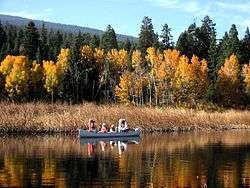Water trail
Water trails (also known as blueways) are marked routes on navigable waterway such as rivers, lakes, canals and coastlines for recreational use. They allow access to waterways for non-motorized boats and sometimes motorized vessels, innertubes, and other craft. Water trails not only require suitable access points and take-outs for exit but also provide places ashore to camp and picnic, and other facilities for boaters.

Water trails may be in public or private waters. In the United States, many water trails are monitored by the National Park Service.[1] Local statutes may apply to landowners who steward water trails and the boaters who use them.[2]
Much of the Trans Canada Trail will be a network of water trails open to canoes and other small vessels.[3]
Recreational use of water trails is a form of ecotourism sometimes called "paddle tourism".[4]
Notable water trails and blueways include:
References
| Wikimedia Commons has media related to Water trails. |
- Water trails and blueways. National Park Service. Accessed 17 March 2017.
- Public Access Guide for Landowners, Water Trails & River Managers. National Park Service.
- Canada Is Building a Trail That Measures Almost 15,000 Miles. Smithsonian 23 September 2016.
- Water Trails. Georgia River Network.